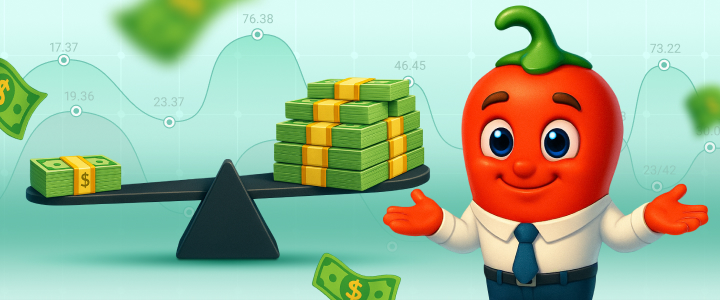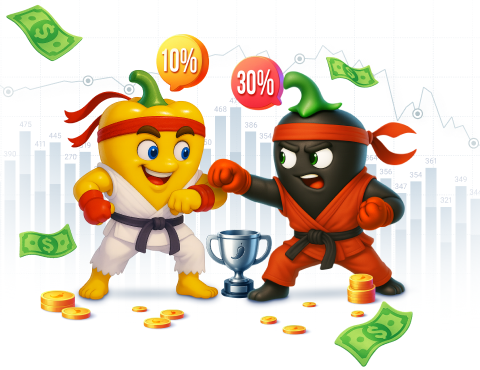Capital Management Methods for High Leverage Trading
07.08.2025
Education
Capital management methods have interested mankind for a long time. In Ancient Babylon, there was a 10.0% rule. This is the share of income that was recommended to be directed to risky investments in order to get rich.

The main difference is leverage. It has become an integral part of trading. Leverage has pushed financial mathematics forward. However, a single theory for trading has not yet been formed. There are disparate ideas. From them, everyone forms their own understanding.
When talking about capital management in trading, they usually throw everything into one heap. Myrtingale, fixed volume, anti-martingale, proportional method, averaging, pyramiding.
At first glance, everything is correct. All these words almost always appear in articles on capital management. But this is not the best approach. The task of capital management is to design an ideal ladder for us. Where each step will say at what amount and what volume to trade.
Everything else should rather be attributed to trading strategies. Doubling a position according to Martingale. Or vice versa, reducing it. Averaging a loss. Adding to a profitable position. All these are strategies for managing an already open position. But not for determining the initial volume.
Ryan Jones was the first to express such ideas. They were liked by the record-holder of trading - Larry Williams. He supported them. Now you can read about the ideas in Jones's 1999 book "Stock Market Game: Make a Million Playing with Numbers".
Despite the humorous title, the content of the book is serious. In it, he identified 2 main methods of capital management. And also formulated his approach. According to Ryan Jones, there are fixed fraction methods. This is when the trader initially determines the ratio. For example, 1 lot for every $10,000 of the deposit.
And there are proportional methods. When the risk per transaction is determined immediately. For example, 1.0% of the deposit. And with this risk, the trader calculates the volume of the transaction. John L. Kelly's formula is built into this method. Ralph Vince adapted it for trading. If the deposit is $10,000, the stop loss in the transaction is 40 points, with a point value of $10.0. Then, the appropriate transaction volume will be 0.25 lots. This will give 1.0% of $10,000.
If everything is so simple, why reinvent the wheel. Ryan Jones noticed the shortcomings of each of the methods. In the fixed fraction, he did not like the preservation of risk as the account grows. And the huge period of time before the volume can be increased. If 1 lot for $10,000. And 2 lots for $20,000. Before the volume grows, you need to double the capital. Now it is all easier. It is possible to split lots. Trade mini-contracts. But in 1999, everything was more complicated.
In the proportional method, Jones found only one big drawback. He called it the "reverse leverage effect." If you lose 10.0% of the deposit in a deal. To get it back, you need to earn 11.1%.
To improve the results, Ryan Jones needed to cross both methods. The result was a fixed-proportional one. His idea is in the steps. Each has space before the volume grows or decreases.
For example, if the initial deposit is $10,000, and the trader sets the step at $4000. Then he will receive an increase in the volume to two contracts for $14,000. $10,000 + (1 contract X for $4,000). Three contracts will be included for $22,000. $14,000 + (2 contracts X for $4,000). And so on.
You can lay down the risk through the "step". The smaller it is, the higher the risk. And vice versa. But in the case of an unprofitable transaction, the reverse leverage effect will not be included immediately. The capital will remain at the same level, even if it grows or falls.

4 thousand years have passed. The 10.0% rule is still relevant. It is promoted by financial gurus. But thanks to the development of technology, there are more opportunities. Trading has taken over the world. And it requires its own capital management methods.
The main difference is leverage. It has become an integral part of trading. Leverage has pushed financial mathematics forward. However, a single theory for trading has not yet been formed. There are disparate ideas. From them, everyone forms their own understanding.
Ideas
When talking about capital management in trading, they usually throw everything into one heap. Myrtingale, fixed volume, anti-martingale, proportional method, averaging, pyramiding.
At first glance, everything is correct. All these words almost always appear in articles on capital management. But this is not the best approach. The task of capital management is to design an ideal ladder for us. Where each step will say at what amount and what volume to trade.
Everything else should rather be attributed to trading strategies. Doubling a position according to Martingale. Or vice versa, reducing it. Averaging a loss. Adding to a profitable position. All these are strategies for managing an already open position. But not for determining the initial volume.
Comparison
Ryan Jones was the first to express such ideas. They were liked by the record-holder of trading - Larry Williams. He supported them. Now you can read about the ideas in Jones's 1999 book "Stock Market Game: Make a Million Playing with Numbers".
Despite the humorous title, the content of the book is serious. In it, he identified 2 main methods of capital management. And also formulated his approach. According to Ryan Jones, there are fixed fraction methods. This is when the trader initially determines the ratio. For example, 1 lot for every $10,000 of the deposit.
And there are proportional methods. When the risk per transaction is determined immediately. For example, 1.0% of the deposit. And with this risk, the trader calculates the volume of the transaction. John L. Kelly's formula is built into this method. Ralph Vince adapted it for trading. If the deposit is $10,000, the stop loss in the transaction is 40 points, with a point value of $10.0. Then, the appropriate transaction volume will be 0.25 lots. This will give 1.0% of $10,000.
Ryan Jones' Method
If everything is so simple, why reinvent the wheel. Ryan Jones noticed the shortcomings of each of the methods. In the fixed fraction, he did not like the preservation of risk as the account grows. And the huge period of time before the volume can be increased. If 1 lot for $10,000. And 2 lots for $20,000. Before the volume grows, you need to double the capital. Now it is all easier. It is possible to split lots. Trade mini-contracts. But in 1999, everything was more complicated.
In the proportional method, Jones found only one big drawback. He called it the "reverse leverage effect." If you lose 10.0% of the deposit in a deal. To get it back, you need to earn 11.1%.
To improve the results, Ryan Jones needed to cross both methods. The result was a fixed-proportional one. His idea is in the steps. Each has space before the volume grows or decreases.
For example, if the initial deposit is $10,000, and the trader sets the step at $4000. Then he will receive an increase in the volume to two contracts for $14,000. $10,000 + (1 contract X for $4,000). Three contracts will be included for $22,000. $14,000 + (2 contracts X for $4,000). And so on.
You can lay down the risk through the "step". The smaller it is, the higher the risk. And vice versa. But in the case of an unprofitable transaction, the reverse leverage effect will not be included immediately. The capital will remain at the same level, even if it grows or falls.
And starting from the second step, each step will be safer. At the second step, $7,000 is accounted for in the calculations for each contract. And at the third step it is already $7,333. At the fourth it will be $8,500. And so on. As a result, the growth of the deposit will exert less psychological pressure.
Conclusion
Each trader uses his own method of capital management. With some adjustments, both the fixed fraction and the proportional method can be set up. The main thing is that each professional strictly adheres to his own rules.
Popular articles
Жаңалықтар
Education
Жаңалықтар
Education
Жаңалықтар
Education
Education
Жаңалықтар
Пікірлер
Education
Жаңалықтар
Education
Education
Жаңалықтар
SpiceProp June Shopping Festival is ON!
26.06.2025
Жаңалықтар
Education
Жаңалықтар
Жаңалықтар
Education
Жаңалықтар
Пікірлер
Пікірлер
Education
Жаңалықтар
Education
What is Prop Trading and How Does it Work?
29.05.2025
Жаңалықтар
Пікірлер
Education
Форекс пен Құмар ойындар
22.05.2025
Жаңалықтар
Пікірлер
Education
Жаңалықтар
Education
Жаңалықтар
Education
Жаңалықтар
Пікірлер
Education
Сауда есебіңізді қалай талдауға болады?
24.04.2025
Жаңалықтар
Пікірлер
Education
Жаңалықтар
Жаңалықтар
Жаңалықтар
Жаңалықтар
Education
Жаңалықтар
Пікірлер
Жаңалықтар
Пікірлер
Пікірлер
Жаңалықтар
Бір, екі, үш... Ең керемет бустерлер осында!
25.03.2025
Пікірлер
Жаңалықтар
Пікірлер
Жаңалықтар
Пікірлер
Жаңалықтар
Пікірлер
Жаңалықтар
Жаңалықтар
Пікірлер
Пікірлер
Жаңалықтар
Жаңалықтар
Жаңалықтар
Жаңалықтар
Пікірлер
Пікірлер
Дионисие Флореа: Трейдингтегі табысқа жету
13.01.2025
Жаңалықтар
Жаңалықтар
Жаңалықтар
Жаңалықтар
Жаңалықтар
Жаңалықтар
Сұхбат
Пікірлер
Жаңалықтар
Жаңалықтар
Жаңалықтар
Пікірлер
Жаңалықтар
Пікірлер
Жаңалықтар
Жаңалықтар
Жаңалықтар
Жаңалықтар
Жаңалықтар
Жаңалықтар
Жаңалықтар
Жаңалықтар
Education
Жедел қаржыландыру – қалай жұмыс істейді?
03.09.2024
Education
Әрбір трейдер көруі керек үздік он екі бейне
29.08.2024
Пікірлер
Сұхбат
Жаңалықтар
Пікірлер
Риад Мазгу: €7 000-нан жоғары пайда табу
12.08.2024
Жаңалықтар
Education
Жаңалықтар
Жаңалықтар
Education
Проп-трейдердің жұмысы – неден бастау керек?
29.07.2024
Пікірлер
Сұхбат
Education
Жаңалықтар
Пікірлер
Education
Проп-трейдер болу үшін не істеу керек?
10.07.2024
Жаңалықтар
Education
Тәуекелге бел бу немесе оны басқаруды үйрен
03.07.2024
Жаңалықтар
Жаңалықтар
Жаңалықтар
Жаңалықтар
Пікірлер
Жаңалықтар
Пікірлер
Жаңалықтар
Жаңалықтар
Жаңалықтар
Сұхбат
Жаңалықтар
Education
Іргелі талдауға кіріспе
06.01.2024
Education
Табысты трейдердің бес ережесі
30.12.2023
Education
Саудадағы эмоцияларыңызды қалай басу керек
12.12.2023
Education
Сауда стратегиясын қалай құруға болады
11.12.2023
Education
Проптрадинг дегеніміз не
11.12.2023
